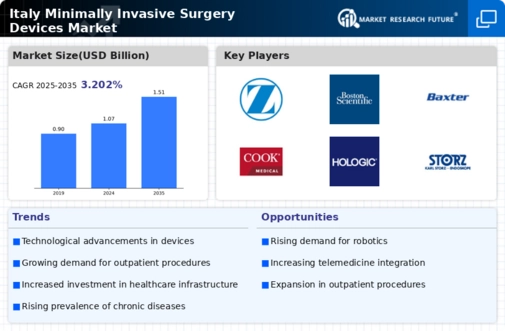Increasing Healthcare Expenditure
Italy's rising healthcare expenditure is a significant driver for the minimally invasive-surgery-devices market. The Italian government has been investing heavily in healthcare infrastructure, with a focus on improving surgical facilities and access to advanced medical technologies. In 2025, healthcare spending is expected to reach approximately €200 billion, reflecting a commitment to enhancing patient care. This increase in funding allows hospitals and clinics to acquire state-of-the-art minimally invasive surgical devices, thereby expanding the range of procedures available to patients. As healthcare providers strive to offer the latest treatment options, the market for minimally invasive devices is likely to experience substantial growth.
Supportive Regulatory Environment
The regulatory landscape in Italy is becoming increasingly supportive of the minimally invasive-surgery-devices market. Regulatory bodies are streamlining the approval processes for new surgical devices, which facilitates quicker access to innovative technologies for healthcare providers. Additionally, reimbursement policies are evolving to favor minimally invasive procedures, making them more financially accessible to patients. This supportive environment is likely to encourage investment in research and development, leading to the introduction of new and improved surgical devices. As a result, the market is expected to benefit from enhanced product availability and increased adoption rates among healthcare professionals.
Rising Prevalence of Chronic Diseases
The increasing incidence of chronic diseases in Italy is a pivotal driver for the minimally invasive-surgery-devices market. Conditions such as cardiovascular diseases, diabetes, and obesity necessitate surgical interventions, which are increasingly performed using minimally invasive techniques. According to recent health statistics, chronic diseases account for approximately 70% of all deaths in Italy, highlighting the urgent need for effective treatment options. This trend is likely to propel the demand for advanced surgical devices that minimize patient recovery time and enhance surgical outcomes. As healthcare providers seek to improve patient care, the adoption of minimally invasive procedures is expected to rise, thereby stimulating growth in the market.
Technological Innovations in Surgical Devices
Technological advancements play a crucial role in shaping the minimally invasive-surgery-devices market. Innovations such as robotic-assisted surgery, advanced imaging techniques, and enhanced surgical instruments are transforming surgical practices in Italy. The integration of artificial intelligence and machine learning into surgical devices is also gaining traction, potentially improving precision and outcomes. The market for surgical robots alone is projected to reach €1.5 billion by 2026, indicating a robust growth trajectory. These innovations not only enhance the capabilities of surgeons but also improve patient safety and satisfaction, thereby driving the demand for minimally invasive surgical solutions.
Patient Preference for Less Invasive Procedures
There is a notable shift in patient preferences towards less invasive surgical options, which is significantly influencing the minimally invasive-surgery-devices market. Patients are increasingly aware of the benefits associated with minimally invasive procedures, such as reduced pain, shorter recovery times, and minimal scarring. Surveys indicate that over 80% of patients prefer minimally invasive options when available, which is prompting healthcare providers to adopt these techniques more widely. This growing demand is likely to encourage manufacturers to innovate and expand their product offerings, further driving the market's growth in Italy.




















Leave a Comment